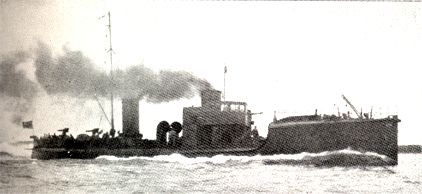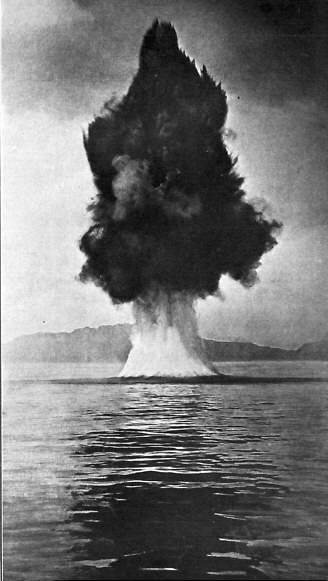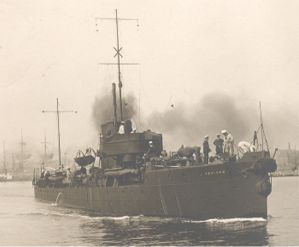|
You are here: 4Campaigns & Battles4Index4The HMS E.13 off Saltholm |
||||||||||||||||||||||||||||||||||||||||||||||||||||||||||||||||||||||||
|
The British Submarine E.13 off Saltholm (1915):
A
deadly morning
|
|||||||||||||||||||||||||||||||||||||||||||||||||||||||||||||||||||||||
|
A British Submarine of the
E-class |
During the night of August 19, 1915 the British submarines E.8 and E.13 attempted to pass through the narrow waters of the Sound, between Denmark and Sweden. The submarines were on passage to reinforce the British submarine forces already operating in the Baltic area. |
Danish and Swedish Naval vessels were patrolling the Sound, protecting the neutrality of these two countries during the Great War.
In combination with heavy mining in the waters, this short passage could quickly turn into a night-mare.
|
The British submarine E.8, commanded by Lieutenant Commander Francis Goodhart succeeded the passage without being spotted. The CO had chosen a route close to the Danish coast, leading him to the west of the small Danish island, Saltholm. E.13, commanded by Lieutenant Commander Geoffrey Layton made a course close to the Swedish coast, leading the sub east of Saltholm. However, the E.13 ran out of luck. Apparently due to a compass failure, the E.13 ran aground in shoal waters, somewhat to the southeast of Saltholm. |
The grounding Point |
The grounding took place inside Danish territorial waters.
Danish Guard Vessel Observe the Grounding
|
The Danish Gun Boat
FALSTER |
At dawn the grounding was observed by a Danish naval vessel on patrol in the Sound. The nationality of the submarine was at this moment unclear to the Danes. The Danish guard ship, the old gun boat FALSTER, under the command of Commander N. Chr. Bay Schmith, was anchored just to the west off Saltholm. The Danish Navy Chief of Staff immediately issued instructions to the Danish ships, ordering: |
-
"If the submarine is German, and other German ships are trying to assist, you shall deliver an official protest.
No other means are allowed.
If the submarine is English, you must forestall any attempt to seize or attack the submarine.
First you should signal an official protest, and if no respect is shown to the protest, you are allowed to use all necessary means available."
These orders were confirmed by the Chief of the Navy, Vice Admiral O. Kofoed-Hansen at 8 o'clock in the morning of August 19th, 1915.
First Danish Torpedo Boat at the Scene
The Chief in Command (C-in-C) of the Naval Floating Defense Squadron at Copenhagen, Rear Admiral Evers, immediately ordered one of the torpedo boats under his direct command, the NARHVALEN (The Narwhal) to investi-gate and protect the Danish neutrality.
|
Around 5 a.m. the Danish torpedo boat NARHVALEN, under the command of Lieutenant J. A. Thiele, was the first ship at the scene and could make a positive identification of the grounded submarine, as a British E-class submarine. Upon arrival, the Danish |
The Danish Torpedo Boat
NARHVALEN |
torpedo boat NARHVALEN immediately went along-side the grounded British submarine and informed E.13's commanding officer (CO), Lieutenant Commander Geoffrey Layton, that the E.13 in accordance with the Danish neutrality and International rules, was required to depart from Danish territorial water within 24 hours.
Lt.Cdr. Layton requested that one of his officers should be transported to the Danish guard ship. This request was granted and would be carried out, as soon as more Danish ships had arrived at the scene.
In view of these time deadlines, if the E.13 was not afloat and out of Danish territorial waters within 24 hours, both the E.13 and its crew would be interned.
Danish Reinforcements are Underway
By direct command from Denmark's Department of the Navy, the 1st Danish Coastal Defense Squadron, under the command of Captain T. V. Garde, was ordered from its anchorage off Skovshoved, just north of Copenhagen, and to proceed to join the other Danish vessels in the vicinity of the E.13.
|
Flagship of the Danish
1st Squadron, |
This squadron included the Command ship, the Coast Defense Ship PEDER SKRAM, under the command of Captain C. V. Carstensen, and the Light Cruiser GEJSER, under the command of Commander T. A. Topsøe-Jensen. The squadron also included the Danish 1st Torpedo Boat Flotilla, under the command of Commander Eduard Haack. The Torpedo Boats SØULVEN (The Sea Wolff), commanded by the Flotilla commander, and TUMLEREN (The Porpoise), under the command of Commander G. Hansen, of the Danish 1st Torpedo Boat |
Flotilla, were ordered to the area where the E.13 was aground.
The two torpedo boats were made to the disposal of the C-in-C, Admiral Evers.
Also the torpedo boat of the Naval Floating Defense Squadron at Copenha-gen, the Torpedo Boat STØREN (The Sturgeon), under the command of Lieutenant Erik Garde, was ordered to the area, to release the NARHVALEN.
Around 8.45 a.m. the 3 Danish torpedo boats arrived at the scene.
The Germans Observe the Grounding as Well
Somewhat later, pursuant to the request from Lt.Cdr. Layton, the Torpedo Boat NARHVALEN came alongside the E.13 and transferred one of the British officers, Lieutenant Paul Eddis, to the Danish guard ship, the FALSTER, situated on just the other side of Saltholm.
|
The German Torpedo Boat G132 |
German naval vessels on patrol just to the south of Saltholm, in the northern part of Koege Bay, had also observed E.13' predicament. The Danish Torpedo Boat STØREN reported that, at around 6 o'clock, a German torpedo boat passed close by the stranded E.13. Initially, the German torpedo boat |
did nothing other than to keep the E.13 under observation.
Further south, there was intensive German radio transmissions, which probably communicated the E.13 predicament, and requested further instructions from the headquarter.
The Battle Begins
At 10.28 a.m. the CO of the SØULVEN, Commander Haack, was reporting that he observed two German torpedo boats approaching from the south at full speed.
The German torpedo boats G132, under the command of Leutnant zur See, Graf von Montgelas, and G134 approached the E.13 from the south.
An attack on the British submarine E.13 was doubtlessly being initialized. On the mast of the G132, one could observe the signal "Abandon ship" being communicated to the E.13.
Immediately upon coming within firing range, the G132 fired a torpedo aimed at the E.13.
|
However, the torpedo missed its target and exploded upon striking the sea floor bottom close to the E.13. The German torpedo boat immediately thereafter employed its deck gun against the defenseless British submarine. Within a short while the sub was was hit several times and fire broke out onboard. The electrical batteries on the sub had been hid and poisonous chlorine gas was spreading inside the sub. After a short time, the sub's CO, Lt.Cdr. Geoffrey Layton, ordered his crew to abandon the burning submarine - There was nothing else they could do in the situation. The attack on the E.13 lasted no more than 3 minutes. |
The torpedo exploded |
Where Were the Danes?
The Danish Torpedo Boats, standing by close to the British submarine, did not directly interfere in the German attack.
Even the 1st Squadron, with the Coast Defense Ship PEDER SKRAM and the Light Cruiser GEJSER, was just keeping the situation under close observa-tion just 5 nautical miles to the north.
At 10.35 a.m. they observed an explosion close to the vicinity of the stranded submarine.
The guns on the Danish ships were manned, but never used.
The Danish ships' inaction occurred despite direct orders from the Danish Navy Chief of Staff, issued early that morning, to protect the stranded British submarine, if necessary by the use of force.
The Danes are Aroused
Immediately after the British CO had ordered his crew to abandon ship and British submariners were attempting to swim the few hundred meters to firm ground, the Danish torpedo boats finally intervened.
|
The Danish Torpedo Boat SØULVEN |
The Torpedo Boat SØULVEN, who was anchored close to the British submarine, slipped her anchor and immediately turned to full speed. At the same time the SØULVEN launched one of her lifeboats trying to rescue some of the surviving submariners. SØULVEN then sailed in between the British submarine and the German torpedo boats, approaching the German torpedo boats at full speed, to protest against this violation of the Danish neutrality. At the same time, the Torpedo Boat STØREN also sailed in between the E.13 and the German torpedo boats, |
and began rescuing the surviving British submariners swimming around in the water.
However, immediately following the Danish intervention, the G132 and G134 aborted their violent attack and were proceeding southward at full speed.
Result - 15 Dead British Submariners
The surviving British submariners, 14 in total, including the CO, Lt.Cdr. Layton, were later brought to Holmen Naval Base in Copenhagen by the Danish Torpedo Boat STØREN.
|
On the very same day, the Royal Danish Navy retrieved the bodies of 14 dead British submariners, all drowned. A few days later, the body of the 15th and last submariner was retrieved. All the dead submariners were brought to Holmen. During the whole episode the English Naval Ensign was flying from the short mast of the E.13. War is Over for Interned Submariners The 14 surviving submariners could |
The abandoned British |
now face the fact that, for them, their participation in the Great War was over.
They would be interned in Denmark, and would only be released at the conclusion of hostilities. For most of them, this is what happened.
As a mark of respect, the dead submariners were repatriated to England for burial on board the S/S Vidar, accompanied by Captain Rørd Hammer of the Royal Danish Navy, and escorted by three Danish torpedo boats.
However, the CO, Lt.Cdr Geoffrey, and his his 1st Officer had another view to the situation. They just simply escaped from internment.
The wreckage of the E.13 was later on salvaged by the Danes, and brought to the Naval Dock Yard in Copenhagen. After the end of the Great War the wreckage was sold for scrap to a Danish firm.
![]()
Follow the Unfolding Story of the E.13:
Read
the Report by Lt.Cdr. Layton to Vice Admiral W. F. Oliver,
Chief of the War Staff, Admiralty
Lt.Cdr. Geoffrey Layton and his 1st Officer Escapes Internment
More In-Depth Articles Coming Up:
This
incident was a major German violation
of the Danish neutrality during the Great
War (1914 - 18)
- What were the consequences?
What were the orders issued by the C-in-C, Rear Admiral Evers?
According
to the dairy of the Chief of the Navy,
Vice Admiral O. Kofoed-Hansen, the Danish
Naval vessels
ignored the situation, in despite of given orders.
Captain Halfdan B. Barfod is postulating
that one of the Danish torpedo boats
ran between
the fighting vessels, and thereby causing a ceased fire.
Who to believe?
- Are someone trying to glamorize the efforts?
What
did the English submarine E13 do in neutral Danish waters,
and what was
her
mission?
|
Sources: |
||
|
& |
Danmarks Flaade, edited by Lieutenant Commander K. Dahl, published by Selskabet til udgivelse af Kulturskrifter, Copenhagen, 1934 |
|
|
& |
Flåden under første verdenskrig - O. Kofoed-Hansens og V. Jøhnkes optegnelser, by Tage Kaarsted, Jysk Selskab for Historie, Universitetsforlaget i Aarhus, 1976 (ISBN 87 504 03 745) |
|
|
& |
Flaadens virksomhed under Verdenskrigen 1914-18, Copenhagen, 1920 |
|
|
& |
"I kamp for flåden - en levnedsskildring af Kommandør Halfdan B. Barfod 1880-1947", told by Jørgen H. Barfod, Maritim Kontakt nr. XXI, Kontaktudvalget for Dansk Maritim Historie- og Samfundsforskning, Copenhagen 1999 (ISBN 87-87947-04-8) |
|
|
& |
Kriegstagebuch der G132, Deutsche Militärchiv |
|
|
& |
Records by Admiral of the Fleet Lord Fisher, Hodder and Stoughton, London 1919 |
|
|
& |
Report by Lt.Cdr. Layton to Vice Admiral W. F. Oliver, Chief of War Staff, Admiralty, (FO 372/660), Archives of the Royal Navy Submarine Museum |
|
|
& |
Vore orlogsskibe fra halvfemserne til nu, af Kay Larsen, Nyt Nordisk Forlag/Arnold Busck, 1932 |
|
|
44You are also referred to the Naval Bibliography |
||
![]()
- Do you miss a major event on this Site,
or do you hold a great story?
Are you able to contribute to the unfolding of
the Danish Naval History,
please
e-mail
me, enclosures are welcome.
Please remember to list your sources.
You can also use the Naval Web Forum on this web-site.
![]()
Follow this unfolding story:
Report by
Lt.Cdr. Geoffrey
Layton to the
British Admiralty
-
Lt.Cdr.
Geoffrey Layton
and his
1st
Officer escapes
Internment
|
MORE IN-DEPTH STORIES FROM |
|
The British Submarine E13 (1915) - The Loss of the submarine DYKKEREN (1916) - Drama in the North Sea (1916) |
|
THE TOPIC STORIES: |
|
- Wars against England (1801-1814) - Reconstructing the Navy (1814-1848) - The 1st Schleswig War (1848-50) - The interim War Years (1850-64) - The 2nd Schleswig War (1864) - The long Period of Peace (1864-1914) - The Navy during the 1st World War (1914-1918) - The Interim Years (1919-1939) - The Navy during the 2nd World War (1939-1945) - The Cold War Period (1945-1989) - |
|
SEE ALSO: |
-
This page was last updated: September 24, 2001
This page was first published: July 29, 2001
Copyright © 2013-2016 Johnny E. Balsved - All rights reserved - Privacy Policy



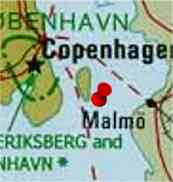
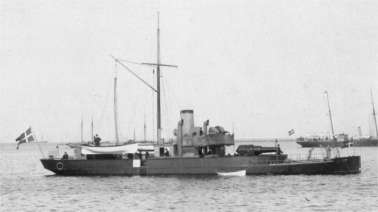
-364-1967_lille.gif)
-3-1979.jpg)
